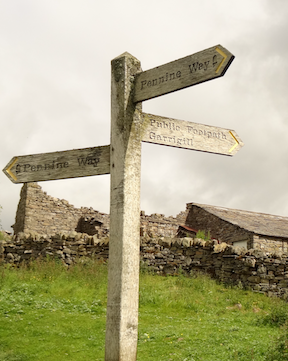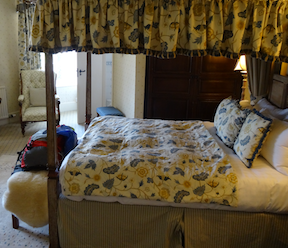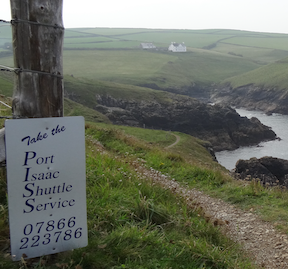Why Walking in Britain
There are a variety of ways to have a walking holiday in Britain.
Since retiring in 2011, I have been on a binge of walking in the UK. Here I will offer some tips based on lessons I have learned. I doubt this will be of much use to someone raised in the UK. Much of what I say here would be obvious or second nature. But lots of things weren’t obvious to me as an American who is unfamiliar with the British countryside.
Why the word “walking?” The words used to discuss the topic at hand are different in British and American English. My authority on language is Lynne Murphy, an American by birth, professor of linguistics at University of Sussex, and author of The Prodigal Tongue: The Love-Hate Relationship Between American and British English.
She has a lot to say on the topic of hiking versus walking. We’re going for immersion in the British activity of walking so the language here will be “walking” and “paths” rather than “hiking” and “trails.”
Of course, English-speakers everywhere use the verb to walk. But for me (at least) what’s different is that I have a town/country divide in my AmE: If I’m walking around town for leisure, I’m going for a walk. If I go out of town to walk (on less even terrain, taking more care with my footwear and supplies), I’m going hiking. Or maybe it’s better characteri{s/z}ed as: if I’m on a paved path/road or the beach, I’m on a walk, and if I’m on less even terrain (fields, woods, mountains, deserts), I’m on a hike.
— Lynne Murphy rambling, hiking, and walking on footpaths and trails
For example, in the UK one has the hard-core Long Distance Walkers Association. Their idea of a good time starts with about 50 miles in a day. Or a more human-scaled example would be The Walking Englishman web site, a great source of information. In these notes and tips I will try to use English terminology (based on my imperfect knowledge) and so will refer to “walking” rather than “hiking.”
Here’s a British tweet that describes how this looks from the British point of view:
I’m always absolutely floored when I realise that the ‘hike’ North Americans are talking about was, in fact, a walk.
— Nell Frizzell (@NellFrizzell) May 7, 2021
More than once while chatting with a local walker on the top of some barren fell1 I have been asked why I have come all the way to England to do my walking. Surely there is plenty of opportunity back in the US. What about the Appalachian Trail? Good question. On a number of multi-mile trudges across boggy moorland I have had plenty of opportunity to think about it.

The UK has a great infrastructure for walking, both short and long distances. One frequently sees the ubiquitous “public footpath” finger posts marking some local public right of way. These footpaths originated as actual transportation routes. There must have been quite a bit of that in colonial New England as well. I don’t know the legal and cultural circumstances that caused those right of ways to be preserved in the UK. In modern times, the powerful Ramblers Association functions somewhat like the National Rifle Association, except for walking rather than guns. The Ramblers lobby for legislation favorable to walkers and actively police existing rights of way.
In the US hiking routes are associated with wilderness or less desirable land that is away from populated areas. In the UK, because many paths grew out of transportation routes, they often go from village to village. One consequence of that is that in the US one has long distance routes such as the Appalachian Trail or the Pacific Crest Trail that emphasize being in the wild and require camping. If wilderness is what you are after, long-settled England is not the place to find it. One might refer to the wild coast of Cornwall on the South West Coast Path, but one is never very far away from a farm or a village. One can feel far from the madding crowd in national parks such as Dartmoor or Exmoor. It does feel a bit wild and isolated. But wilderness is not the word that describes it.

For an urbanized senior citizen such as myself, the creature comforts available in the UK are a big attraction. Even on the long distance routes one can walk from village to village and stay in a cozy B&B, pub, or small hotel at the end of the day. One starts the day with a full English breakfast and follows a full day of walking with a hot shower, a solid evening meal in the local pub, and finally a comfortable bed (we hope). The type of walking I do in the UK is fundamentally different from the Appalachian Trail. Plus there are no bears or mountain lions or rattlesnakes to trouble my calm reflections during the walk.
Another plus is public transportation, even away from cities and towns. If one wants to do a simple walk, it is often possible to take bus out somewhere and walk back to your hotel. Here in Connecticut where I live, there is a very nice set of trails (the Blue Blazed Trails), but almost none of them are near bus routes or motels or places to get food. Invariably one has to drive to a trail head. That’s true for many foot paths in the UK as well, but there are also many that are available via public transportation. A couple of times I have decided to cut the day short and catch a bus for the rest of the trip. Sometimes there are even simple ferries to get you across an estuary. And even in rural areas there often is some sort of taxi service available.

There are other aspects of the UK that probably make a difference. There is less suburban sprawl and less dependence on cars. In my part of the world one does not expect to find a motel or hotel anywhere except in a city or near a highway exit. In the UK B&B’s and small-scale hotels seem more plentiful. I don’t claim to understand all the political, cultural, and legal factors that create those differences in the environment. But the result is good for walkers.
I’ll mention one other factor about the English landscape: sheep. I like sight lines. I enjoy walking through woods now and again, but I’m not so big on a full day of it. I like to get out in the open and see a long distance. In the American West, desert or altitude clear away the trees and give the hiker an unobstructed view. I like that kind of walking. In ancient times Britain was covered in forests. (Well, maybe not completely covered.) In large swaths of Britain the land is kept clear of trees by grazing animals, primarily sheep. Sometimes one will see a small stand of trees protected by an old stone wall enclosing the grove. There are lots of wooded areas in the UK and perhaps I’m overstating things a bit. But I associate areas like North Yorkshire with rolling green hills clear of trees. In Connecticut a long walk invariably involves a walk in the woods.
All in all, walking in the UK is a more visible and popular activity than hiking is in the US. There are TV shows, books, guides, and maps in far greater volume than in the US. Alfred Wainwright is the the key figure in the modern popularity of walking in Britain, especially the Lake District. He basically invented the route for the Coast to Coast Path, which is one of the most popular routes even though it is not one of the official National Trails. The original Wainwright guide books are now somewhat out of date, but his enthusiasm is contagious and his drawings are quite charming. If your local public library has a copy of one of his pictorial guides (such as A Coast to Coast Walk), take a look.
There are lots of other examples of the popularity of walking in Britain. Julia Bradbury has a series of TV programs on walking including the Coast to Coast Path and another on Best Walks and even railway walks.
There are plenty of books extolling the pleasures of walking in Britain. The National Trails of England, Scotland and Wales by Paddy Dillon provides a modern overview of each of the national trails with pictures, text, and a map to orient you. A book which is significant for me is The National Trust Book of Long Walks in England, Scotland and Wales by Adam Nicolson with photographs by Charlie Waite. This book was my introduction to the long distance trails in Britain. After stumbling on the existence of the Pennine Way in 1997, I wanted to know more and found the Nicolson book in the New Haven Public Library after I returned home. (A couple of years ago I bought a used copy from Amazon.)
I’ll leave it to Julia Bradbury and the authors of these books to wax lyrical about the glories of British walking. In these notes I will be much more prosaic.
Types of Walks
The first trip I took on my own to England was planned as a car trip around North Yorkshire. But I quickly realized that if I went to the local tourist information center (TIC) there often was information about some local walks. I ended up doing a number of half-day walks, including two that lay the ground work for an enduring interest in walking in Britain. So mixing car touring with walking is an entirely reasonable way to go. On a trip in Wales I arranged to stay for two nights in each of three places. That often worked out to be a half day walk on the day I arrived and then a full-day of walking before staying the second night. I started out with two days in Wotton-under-Edge and a full-days’s walk on the Cotswold Way, two days in St. Davids in Wales and the Pembrokeshire Coast Path and then two more nights in the northern half of Wales. There are lots of areas where one could do something like that. With a bit of planning, one could do something like that via bus or train and avoid the car entirely (a big plus if one has qualms about driving on the left side of the road).
Tour Companies
There are many companies that arrange walking holidays2. More than 20 years ago, I used Walkers’ Britain (formerly Sherpa Expeditions) for a self-guided tour on the West Highland Way. More recently I’ve used Encounter Walking to do the Two Moors Way in Devon. Encounter specializes in the Wales and the South West area of England. A “self-guided” tour means that the tour company will organize a route and accommodations, provide you with a map and directions, and can also arrange to transport your luggage. Guided tours mean that you walk with a group. I have done two group tours using REI, one in the US and one in Greece, but my walks in the UK have either been self-guided or else I’ve made all the arrangements myself. I can’t claim to have any expertise about guided tours in the UK. Relying on a tour company to organize your walking holiday is a good way to get started. It’s a definite possibility, and well worth your consideration. Just search “walking” and “tours” and “britain” or “England” or “Scotland” and you will find a lot of options.
There are also walking holidays that are organized out of a particular inn. You stay there for a period of time and each day your hosts arrange transportation to and from a walk for that day. This is not something I have any experience with.
Camping
Although I’ve made it clear that camping is not my cup of tea, plenty of people do make their way along the long-distance trails in Britain camping in much the same way as Americans on the Appalachian or Pacific Coast Trails. It’s not something I know anything about so all I can do is acknowledge that it is a popular possibility.
Multi-day Walks
After doing the Sherpa-organized walk on the West Highland Way (more than twenty years ago) I thought to myself that I could arrange that myself. And that’s what I have been doing. What I am hoping to do in these posts is to share some practical advice on doing a multi-day walk in Britain. Does it seem as though I am deliberately mystifying the whole process? Not at all. The point I hope I have made is that there are lots of things in Britain that come together to make a walking trip easy and satisfying. And there is tons and tons of information available. Like all travel activity, the web provides lots of ways to get useful information. But if you are contemplating a trip on one of England’s National Trails or other trails such as The Coast to Coast Path or the West Highland Way, buy a guide book. Trailblazer seems to dominate the market, at least for some trails in Britain. I have used a bunch of Trailblazer guides. They have a similar style and organization although different authors. They are loaded with very practical information including details about route, accommodations, and services. They include useful hand-drawn maps of the route. Often you can find them on Amazon or other sites in the US, but you can also order them directly from Trailblazer. I just checked their web site and I am shocked to see that they seem to offer free shipping world wide. Of course there are other guide books available as well.
If you rely on a guidebook for navigation, check whether they have a page of errata or updates available online in case there is some amendment to some detail of the route. Here an example for the Trailblazer Hadrian’s Wall Path guide book:
August 2020
p137, Map 16. The location of the bridge abutment should be opposite the south east facing wall of Chesters fort on the straight section of the river ie north east of where it is currently marked on the map.
They also include some detailed feedback from previous readers.
What Next?
So much for general introduction. What I aspire to do in these posts is something like what The London Hiker does for the city-bound in London. I will try to address particular topics and try to include the kinds of details that I didn’t know before my first walking holiday. Here’s the plan. Next step will be for me to fill this in.
My Experiences Walking in the UK
What experience are these notes based on? By the standards of someone who has lived in Britain, perhaps not very much. I did some day walks during a car tour of Yorkshire in 1997. Based on a Rick Steve guide I stayed one night in Thwaite in North Yorkshire. I did a wonderful half-day walk almost to the top of the Great Shunner Fell. In Thwaite there was a finger post pointing to the Pennine Way, which goes through Thwaite, and the Coast to Coast Path which passes nearby through Keld. I was intrigued about what those referred to and did some research after I returned home. Based on some advice, I did the West Highland Way in 1998. I didn’t return to England until 2007 when I walked the stretch of the South West Coast Path between Padstow and St. Ives. I had a marvelous trip, which included two days in Dartmoor and one day on the final stretch of the South Downs Way that follows the white cliffs along the English Channel into Eastbourne. Some foot problems kept me away for a couple of years, in 2011 I did a couple of days along Hadrian’s Wall and in 2012 some walks on the Pembrokeshire Coast Path in Wales. That went so well that I really caught the walking bug. I did most of the Coast to Coast Path in 2012. In 2012 and 2013 I did the Pennine Way, broken into two trips. In 2015 I did the South West Coast Path from the start in Minehead to my earlier start in Padstow. And in 2019 I did the Two Moors Way (with bits of Dartmoor and Exmoor in Devon) and the Cleveland Way in Yorkshire. Post-pandemic I did Lady Anne’s Way, which mostly is in North Yorkshire.
Topics
- Choosing a path
- Planning an itinerary
- Arranging for accommodations
- Luggage transport
- Food
- Money
- What to bring
- Packing
- Navigation
- Rain (and how to cope)
- Training, Fitness, and Foot Care
- Safety
Footnotes
A “fell” is a term primarily used in northern England or Scotland for a hill top. Often appears in place names such as Cross Fell. See also fell running.↩︎
More language issues: they say “holiday” where we say “vacation.”↩︎